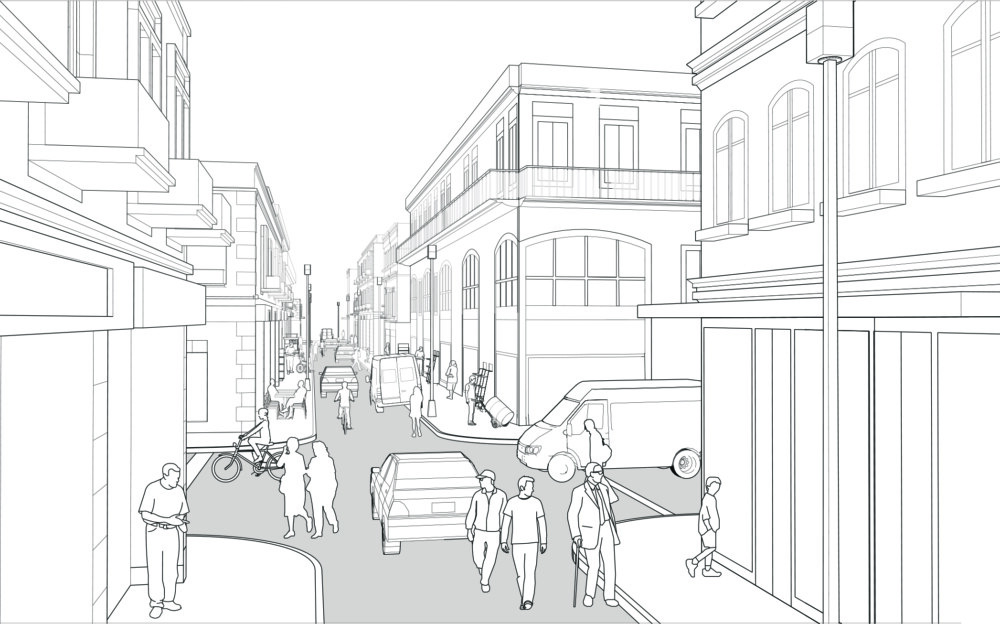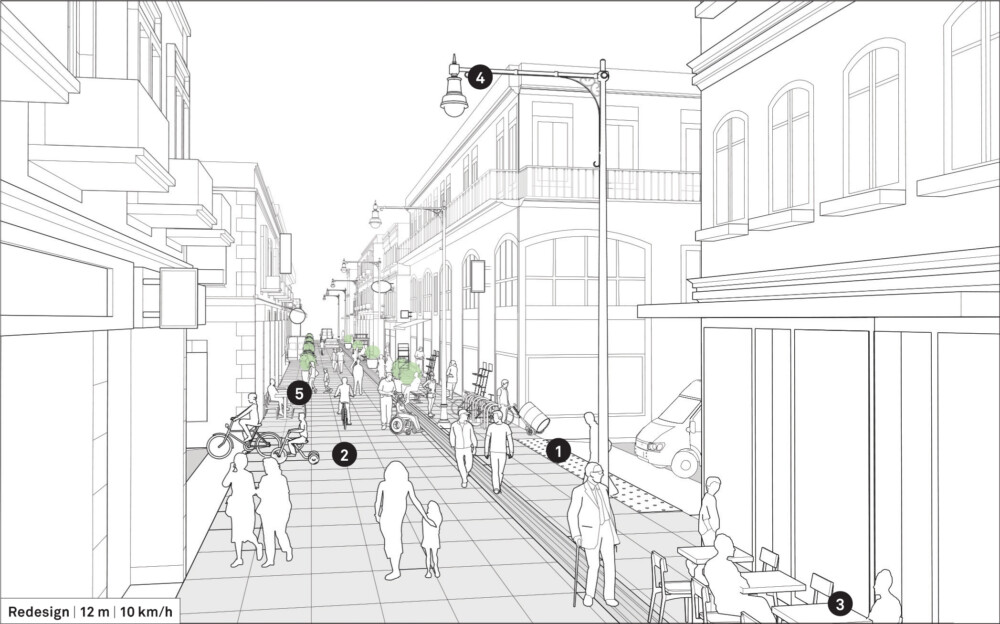-
About Streets
- Introduction
- Defining Streets
-
Shaping Streets
- The Process of Shaping Streets
- Aligning with City and Regional Agendas
- Involving the Right Stakeholders
- Setting a Project Vision
- Communication and Engagement
- Costs and Budgets
- Phasing and Interim Strategies
- Coordination and Project Management
- Implementation and Materials
- Management
- Maintenance
- Institutionalizing Change
- Measuring and Evaluating Streets
-
Street Design Guidance
- Designing Streets for Great Cities
- Designing Streets for Place
-
Designing Streets for People
- Utilities and Infrastructure
- Operational and Management Strategies
- Design Controls
-
Street Transformations
- Streets
-
Intersections
- Intersection Design Strategies
- Intersection Analysis
- Intersection Redesign
- Mini Roundabout
- Small Raised Intersection
- Neighborhood Gateway Intersection
- Intersection of Two-Way and One-Way Streets
- Major Intersection: Reclaiming the Corners
- Major Intersection: Squaring the Circle
- Major Intersection: Cycle Protection
- Complex Intersection: Adding Public Plazas
- Complex Intersection: Improving Traffic Circles
- Complex Intersection: Increasing Permeability
- Resources
Global Street Design Guide
-
About Streets
- Introduction
- Defining Streets
-
Shaping Streets
Back Shaping Streets
- The Process of Shaping Streets
- Aligning with City and Regional Agendas
- Involving the Right Stakeholders
- Setting a Project Vision
- Communication and Engagement
- Costs and Budgets
- Phasing and Interim Strategies
- Coordination and Project Management
- Implementation and Materials
- Management
- Maintenance
- Institutionalizing Change
-
Measuring and Evaluating Streets
Back Measuring and Evaluating Streets
-
Street Design Guidance
-
Designing Streets for Great Cities
Back Designing Streets for Great Cities
-
Designing Streets for Place
Back Designing Streets for Place
-
Designing Streets for People
Back Designing Streets for People
- Comparing Street Users
- A Variety of Street Users
-
Designing for Pedestrians
Back Designing for Pedestrians
- Designing for Cyclists
-
Designing for Transit Riders
Back Designing for Transit Riders
- Overview
- Transit Networks
- Transit Toolbox
-
Transit Facilities
Back Transit Facilities
-
Transit Stops
Back Transit Stops
-
Additional Guidance
Back Additional Guidance
-
Designing for Motorists
Back Designing for Motorists
-
Designing for Freight and Service Operators
Back Designing for Freight and Service Operators
-
Designing for People Doing Business
Back Designing for People Doing Business
-
Utilities and Infrastructure
Back Utilities and Infrastructure
- Utilities
-
Green Infrastructure and Stormwater Management
Back Green Infrastructure and Stormwater Management
-
Lighting and Technology
Back Lighting and Technology
-
Operational and Management Strategies
Back Operational and Management Strategies
- Design Controls
-
Street Transformations
-
Streets
Back Streets
- Street Design Strategies
- Street Typologies
-
Pedestrian-Priority Spaces
Back Pedestrian-Priority Spaces
-
Pedestrian-Only Streets
Back Pedestrian-Only Streets
-
Laneways and Alleys
Back Laneways and Alleys
- Parklets
-
Pedestrian Plazas
Back Pedestrian Plazas
-
Pedestrian-Only Streets
-
Shared Streets
Back Shared Streets
-
Commercial Shared Streets
Back Commercial Shared Streets
-
Residential Shared Streets
Back Residential Shared Streets
-
Commercial Shared Streets
-
Neighborhood Streets
Back Neighborhood Streets
-
Residential Streets
Back Residential Streets
-
Neighborhood Main Streets
Back Neighborhood Main Streets
-
Residential Streets
-
Avenues and Boulevards
Back Avenues and Boulevards
-
Central One-Way Streets
Back Central One-Way Streets
-
Central Two-Way Streets
Back Central Two-Way Streets
- Transit Streets
-
Large Streets with Transit
Back Large Streets with Transit
- Grand Streets
-
Central One-Way Streets
-
Special Conditions
Back Special Conditions
-
Elevated Structure Improvement
Back Elevated Structure Improvement
-
Elevated Structure Removal
Back Elevated Structure Removal
-
Streets to Streams
Back Streets to Streams
-
Temporary Street Closures
Back Temporary Street Closures
-
Post-Industrial Revitalization
Back Post-Industrial Revitalization
-
Waterfront and Parkside Streets
Back Waterfront and Parkside Streets
-
Historic Streets
Back Historic Streets
-
Elevated Structure Improvement
-
Streets in Informal Areas
Back Streets in Informal Areas
-
Intersections
Back Intersections
- Intersection Design Strategies
- Intersection Analysis
- Intersection Redesign
- Mini Roundabout
- Small Raised Intersection
- Neighborhood Gateway Intersection
- Intersection of Two-Way and One-Way Streets
- Major Intersection: Reclaiming the Corners
- Major Intersection: Squaring the Circle
- Major Intersection: Cycle Protection
- Complex Intersection: Adding Public Plazas
- Complex Intersection: Improving Traffic Circles
- Complex Intersection: Increasing Permeability
- Resources
- Guides & Publications
- Global Street Design Guide
- Streets
- Shared Streets
- Commercial Shared Streets
- Example 1: 12 m
Example 1: 12 m


Existing Conditions
Shared streets are often the default condition in historic cities with narrow rights-of-way. One or two narrow travel lanes may be shared between cars, motorcycles, cycles, and loading vehicles. Due to the limited space, these streets may have narrow and inaccessible sidewalks, with utility boxes and light poles obstructing the pedestrian space. In some contexts, sidewalks are occupied by street vendors and informal parking, forcing pedestrians onto the roadbed.

Bandung, Indonesia. A narrow street hosts commercial activity and acts as a defacto shared street.
Design Guidance
Design strategies must prioritize vulnerable users, ensuring that clear paths are maintained. Work with local accessibility groups to ensure design, materials, and facilities meet local guidelines or standards.
Consider local climate and material availability when developing design. Drainage channels and permeable materials should be provided in accordance with existing curb lines and slope.
Textures and paving must align with the curb to reinforce the pedestrian-priority of the street.
![]() Provide tactile warning strips at the entrance to all shared spaces. Warning strips should span the entire intersection crossing. See: Universal Accessibility.
Provide tactile warning strips at the entrance to all shared spaces. Warning strips should span the entire intersection crossing. See: Universal Accessibility.
![]() Maintain a clear path for delivery vehicles, and mark dedicated areas for vehicular movement with a change in paving pattern or type.
Maintain a clear path for delivery vehicles, and mark dedicated areas for vehicular movement with a change in paving pattern or type.
![]() Use street furniture, including benches, planters, artwork, trees, water fountains, bollards, and cycle parking, to provide definition within the shared space and to delineate the travel lane from pedestrian-only areas.
Use street furniture, including benches, planters, artwork, trees, water fountains, bollards, and cycle parking, to provide definition within the shared space and to delineate the travel lane from pedestrian-only areas.
Depending on the overall street width, consider providing a 1.8 m wide, continuous clear path that is protected from traffic to ensure universal accessibility.
Install signage to educate the public on how to use a shared street in the early stages of conversion.
![]() Light the streets evenly to create a safe and inviting environment. Light poles and fixtures for shared streets can be designed to add character and a sense of the local context. See: Lighting design Guidance.
Light the streets evenly to create a safe and inviting environment. Light poles and fixtures for shared streets can be designed to add character and a sense of the local context. See: Lighting design Guidance.
![]() Include landscaping, such as planters and trees, where possible. Incorporate permeable pavers and rain gardens as a part of the larger green infrastructure and water- management strategies.
Include landscaping, such as planters and trees, where possible. Incorporate permeable pavers and rain gardens as a part of the larger green infrastructure and water- management strategies.
Use movable planters to restrict vehicular traffic access at certain times of the day.
Cities are encouraged to experiment with car-free hours or test shared streets using temporary materials to evaluate the potential impact on traffic operations.
Adapted by Global Street Design Guide published by Island Press.
Next Section —